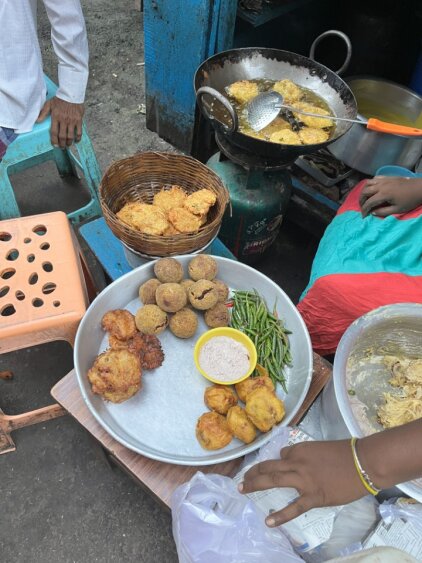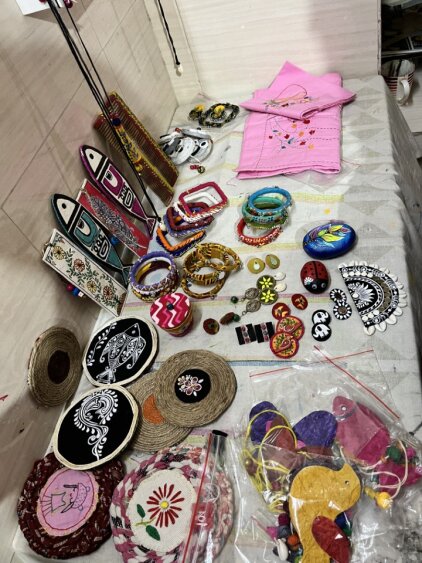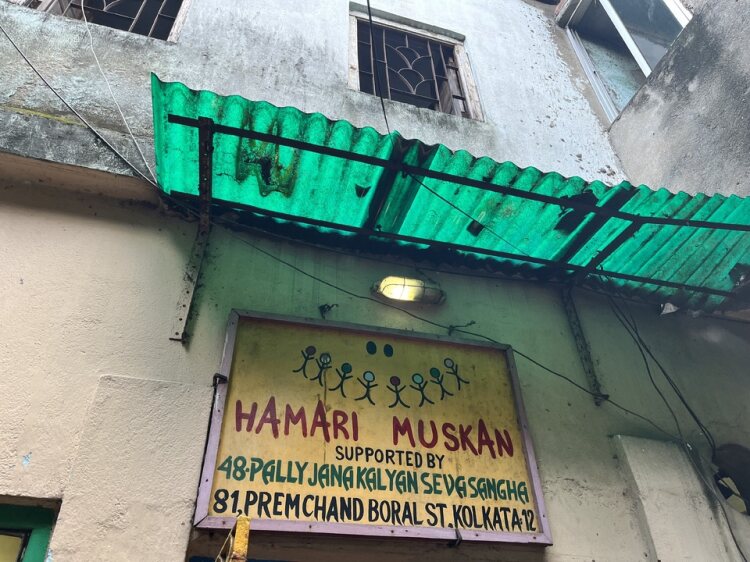“I have two daughters and I wouldn’t want them to be prostitutes, so how can I accept that for someone else’s daughter.”
– Paromita, COO, SKHM
Human trafficking is the fastest growing and largest criminal industry in the world, and Kolkata houses the largest red-light area in Asia. Each step we (Saleha and Mahasweta) took that day felt like a stark reminder that we had the privilege of choice, unlike the women trapped in this labyrinth of despair. Thus, it is evident that the day was filled with emotions, reality checks, and an understanding of resilience.
Inside the humble office of South Kolkata Humari Muskan (SKHM), we were met with warmth and kindness, as if these small rooms held the hope of an entire community. It was a small two-bedroom flat converted into an office. We got to speak with the leader, Srbani Sarkar Neogi, a professional with over 30 years of experience in working with prostituted women, and Paromita, who almost cracked Chartered Accountancy and then studied psychology and completed several courses on Psychotherapy.
“Prostitution is not a profession; women are forced into it, so we don’t call it sex work.”
– Srabani Sarkar Neogi, Director
Diving deep:
In the depths of Kolkata’s red-light areas, home and workplace are the same. Whenever an infant cries from under the bed while she is attending to a customer – the mother resorts to mixing alcohol into their milk, a tragic precursor to a life of early addiction and exposure to sexual activities.
Working in the red-light area presents significant challenges. Local clubs, often controlled by mafia which are supported by politicians, serve as the safest entry point into this area. SKHM began by convincing the locals that they were a child protection organization dedicated to educating the children of prostitutes. It started with working with kids, providing them safe space education and counselling. Soon they realized that to break the cycle, SKHM needed to work with the mothers. The children’s daytime education would amount to little if their mothers were not supportive and understanding at night. Thus, SKHM expanded its efforts, identifying hobby classes such as candle making and cooking. This initiative paved the way for the Dignity program in 2017, aiming to prevent the second generation from falling into prostitution’s grasp. Their strategy is ‘Gate-keeping’ and ‘Exit’ – prevention of second generation from getting into the cycle and helping women breakout with sustainable income.
Mental health is a crucial part of all their program designs and interventions. Through mental health awareness and practice, they help the individuals build agency and stand-up for their rights

Mental health is a crucial part of all their program designs and interventions. Through mental health awareness and practice, they help the individuals build agency and stand-up for their rights. For children up to 10 years, they have introduced play therapy. Play therapy is a therapeutic approach that recognizes that children often struggle to express their feelings and thoughts verbally, especially when facing emotional or psychological challenges.
Instead of relying on traditional talk therapy, play therapy allows children to communicate and process their emotions through various forms of play and creative expression. Children above 10 years old are a part of group therapy. Often, children above the age of 10 are unresponsive to group therapy. Therefore, a ‘peer support’ system has been introduced, where responsive children assist or prevent unresponsive ones from falling into detrimental patterns. These responsive children also inform the SKHM team about the actions of the unresponsive children. In all group sessions, Srbani attends as a participant to better understand the feelings of the children.
Mental health is of paramount importance in SKHM especially among caregivers in the field team who are mostly from the community of prostitution. When they express a desire to eat more and request extra food, even if they cannot consume it all, the team does not refuse. Even if it results in some wastage, it is considered acceptable. This practice is deeply connected to the well-being of these individuals and reflects the commitment to upholding their dignity as human beings.
One eye-opening aspect of our discussions on mental health was the willingness of the office team to openly address salary concerns within the NGO sector, even in the presence of SKHM’s CEO. While Srbani noted their efforts as an NGO to maintain industry standards, the persistently low pay in the NGO sector significantly impacts mental well-being.
Lifecycle of Prostitution:
It’s noteworthy how women in these areas adapt their religion and surname based on their clients. They wear sindoor and sakha-pola, symbols of married Bengali women, prioritizing emotional connection over everything else. Denied by their families, they yearn for emotional connection from their clients.
SKHM works in two major red-light areas of Kolkata, Sonagachi (upper class) and Bowbazar (lower class). In Bowbazar, women are trafficked from different districts of Bengal: Birbhum, Murshidabad, North 24 Paraganas and South 24 Paraganas. In Sonagachi, women are trafficked from Rajasthan, Madhya Pradesh, Nepal, Bangladesh and Bihar. Women at both places are from Scheduled Caste and Scheduled Tribe families. A woman’s price depends on her age and beauty.
At the age of 13, an event known as “Nothtorwani” takes place, where a girl loses her virginity to the highest bidder in a dehumanizing auction, sometimes fetching up to 5 lakhs for a single night. As time passes, the number of clients dwindles. By the age of 30, they are left with few, if any, clients. At 40, they are relegated to tertiary activities, like caring for children,household chores or selling alcohol. The older women, devoid of sexual attention, often resort to abusing younger boys or girls for their pleasure. The boys born here often become pimps or run illicit enterprises like marijuana and alcohol shops. The girls are expected to follow in their mothers’ footsteps, becoming prostitutes themselves. Living in a red-light area is a relentless battle. There is a constant threat of unwanted touch and abusive slurs. SKHM prevents the children from staying with these older women and provides a safe space.
Working with children:
After a yummy lunch, we headed to the tiny narrow lanes of Bowbazar area. When we entered we saw the lanes with shops of goldsmiths followed by the lanes where prostitution takes place. It was 5 pm and women were getting ready for their clients. Some decked up as Krishna – because the next day happened to be Janmashtami. We passed these women and then entered a club area converted to a lively place where all the women belonging to the Dignity program were making jewelry for selling at an exhibition. Then we entered a room where adolescent boys and girls were studying. We interacted with the young adults around 16 to 18 years old and were studying in college. These children were from the first batch SKHM started working with back in 2009. The transformative work SKHM has done was clearly visible in their confidence, pride in their identity, respect for their mother’s profession and understanding of mental health. They were bold, articulate and tech-savy, did not seek empathy but demanded equality for next generation.

The transformative work SKHM has done was clearly visible in their confidence, pride in their identity, respect for their mother’s profession and understanding of mental health. They were bold, articulate and tech-savy, did not seek empathy but demanded equality for next generation.
When they see us studying in college, unki bolti bandh ho jati hai” – said Saraswati, who came to SKHM’s centre in 2015 when she could not speak without tearing up. Today she studies Mass Communications. These young adults are a part of Learn and Earn program that helps them study as well as earn a decent stipend.
It was heartwarming to see that these children had a deep understanding of mental health, often surpassing that of many adults. Their insight was truly remarkable.
Here are their responses to the two questions we asked them:
What are your aspirations?
The young adults have distinctive aspirations. They value qualities like compassion and respect over traditional careers and are committed to challenging stereotypes tied to their background. The young adults proudly acknowledge their origin from a red-light area and aspire to create a
future where children are not judged based on family history, emphasizing the dignity in their mother’s profession.
What does Mental Health mean according to you?
Mental health plays an important role in managing emotions and fostering interpersonal connections, as significant as maintaining physical fitness. Emphasizing the need for both mental and physical well-being, it involves regulating emotions, averting extremes of anger or sadness, and addressing trauma-related symptoms, such as sleep disturbances and selfdestructive behaviors. Mental health encompasses coping with feelings of being unloved and
confronting personal challenges. It encourages individuals to redirect their focus from dwelling on negatives toward nurturing a positive life outlook while proactively addressing underlying issues. In essence, mental health is an indispensable facet of overall well-being that underpins emotional resilience and constructive interpersonal relationships.
Filled with positivity and inspired by our interactions, we continued our journey. As we stepped outside, we met a woman from the Dignity program, busy making “telebhaja” or deep-fried onion snacks. After enjoying a bite, we proceeded to the next center where women and young girls from the Dignity Program were participating in jewelry-making classes. Simultaneously, children aged 0-6 years received private coaching and childcare on the second floor of the building. After engaging with the children and their teachers, we headed to our final destination of the day, Sonagachi.
Upon our arrival in the club area in Sonagachi at 7:30 PM, we found adolescent girls and boys participating in a drama class, eagerly awaiting our visit. Some of them spoke Hindi, as their mothers had migrated from North India. This batch of children was relatively shy but did share their aspirations of becoming dancers or working in beauty parlors.



Snapshots of Women from the Dignity program making jewelry and snacks.
Housing, Infrastructure and Sanitation:
It was late evening, the prime time for prostitution work, so we were cautioned to be careful. The streets were relatively empty as potential clients had traveled to their villages for Janmashtami celebrations. As we walked through the narrow lanes, the stench from the open toilets and bathrooms was overwhelming. The washrooms had no doors or curtains and continued to demonstrate the lack of dignity that these women faced daily.
The houses would be around 150 years old, and although old and dilapidated now, if you looked closely, you could see the beauty in their architecture. If you listen closely, you wonder about the stories the walls could tell. Each room measured roughly 50-100 square feet, accommodating 4-5 residents. The beds were typically raised, providing limited space beneath them for storage of utensils and other essentials.
The Agrawali houses in Sonagachi stood out prominently among the others, as they were generational brothels exclusively serving politicians and wealthy men. These establishments were known for their opulent settings and employed bouncers who enforce restricted entry. The young women from these families often received formal education at institutions like Rishi Valley and Dhoon School before returning to join back as high-end escorts.
We visited the home of a woman in her late 40s from Bangladesh who had been forced into prostitution at the age of 13. When she realized we were from Mumbai, she shared her dream was to visit the city. She welcomed us whole-heartedly and offered tea, biscuits, water, and even a guava. While we were leaving, the other women wanted us to visit their homes too and only let us leave with the promise that we will visit the next time.
It was 9:00 PM and as we made our way back to the SKHM office, , the lanes of Sonagachi were awake and bustling with anguish and hope. Our hearts heavy with the stories we heard, and minds charged with determination.
And as Paromita rightly said that it has been multiple generations of women forced into prostitution, and so it will take a few generations to get them out. On that note, we will not give up hope!


Areas of support:
- Communications: Due to the sensitive nature of the work, SKHM maintains a low profile and does not have the capacity for social media or any media engagement. They prefer to avoid it, as it could potentially attract unwanted attention.
- Leadership: They have not considered developing leadership among young adults from families involved in prostitution. Their goal is to help these children transition out of this world, ensuring they do not move directly from being beneficiaries to becoming service providers.
- Needs:
- Fundraising Support: SKHM needs assistance with writing effective proposals, explaining their needs to potential donors and building a strong pipeline of funders. They have been advised to incorporate climate change into their proposals, despite having other pressing issues to address. Additionally, they require workshops on developing a theory of change. They would like to get updates of ongoing funding opportunities, such as the Lulu Lemon grant of USD 44,500 where they have reached till the final stage.
- Residential School: Due to the increasing challenges of staying with their parents, there is a pressing need for a residential school. The government facilities struggle to comprehend the unique circumstances of children from red-light areas, and thus not an immediate option.
- Support for Older Ex-Prostitutes: Older ex-prostitutes face significant financial hardships and a lack of care. There is a dearth of attention to their geriatric care needs, including addressing menopause and other health issues.
- Marketing model: The biggest challenge in moving women out of prostitution is providing them with alternative livelihoods. If marketing is done well of products produced by them in the Dignity program, it will be easier to help women transition. Need dedicated department for building a business model.
- Research: Research plays an important role in constantly upgrading SKHM’s work, and they currently do not have the bandwidth to hire someone for research.
Flexible Funding
SKHM is strategically utilizing flexible funds from the Rebuild India Fund to address critical needs. These funds are allocated for providing stipends to young adults and women, making alternate livelihood more sustainable. The funds will be covering rents for local clubs where children, young adults, and mothers stay throughout the day. Plans are in place to distribute essential dry rations to approximately 250 families, particularly during Durga Puja, a significant festival for Bengalis, when a special ration kit consisting essential food items is distributed.
Additionally, SKHM is investing in its staff’s mental health and well-being through retreats and external psychologist support. This comprehensive approach ensures that not only are the immediate needs of vulnerable families met, but also that the resilience and mental health of the organization’s staff are nurtured, enabling them to continue their vital work in combating human trafficking and supporting marginalized communities.

From the Travellers:
“Growing up in Calcutta, I was constantly cautioned against venturing into the alleys of Sonagachi, a place shrouded in a sense of fear and mystery. The site visit shattered those preconceived notions and opened my eyes to a world I had known so little about. It made me realize the stark lack of representation of marginalized communities in Kolkata’s public spaces.
One crucial lesson I learned during my visits was the distinction between prostitution and sex work, as highlighted by organizations like SKHM. Prostitution often involves women who are coerced into this profession, while sex work by choice is an entirely different matter and should not be stigmatized. The real issue lies in human trafficking, which results in individuals being forced into prostitution against their will.
During the visit, it became evident that transitioning to alternative livelihoods after leaving prostitution does not offer financial security or societal acceptance. This stark reality highlights the need for broader societal support and understanding.
What struck me most during my visits was the resilience and strength of the young adults I met. They were not seeking pity but rather demanding the respect they rightfully deserve. I witnessed a remarkable sisterhood among the prostituted women after moving out of prostitution, which was a stark contrast to the stereotypes of competition and rivalry among them earlier for clients.” – Mahasweta
“I have lived at Grant Road, Mumbai my entire life, which is walking distance from Kamathipura, Mumbai’s largest red-light area. Since we passed Kamathipura fairly frequently, my parents explained to us why it is important to respect and not judge the women which comprised of bar dancers and prostituted women. I thought I knew enough and visiting a red-light area in Kolkata would not shock me. But I was in for a surprise. While I may have passed Kamathipura often, I have never ventured deep into the by-lanes or visited a home/workplace of a prostituted woman. I was so moved and so ashamed of the lack of humanity and dignity humans inflict on other humans. Human trafficking is the second most profitable business in the world after arms and drugs, so I feel almost hopeless to imagine a world free of this evil.
I try to see people beyond an overall statistic and each individual life that is impacted. To an individual, their life is a 100%. So with the work that SKHM is doing, we got to witness the impact with our own eyes. It’s painfully slow but I feel even more motivated to do the work I do, so we can help the women and children we met through SKHM.” – Saleha



